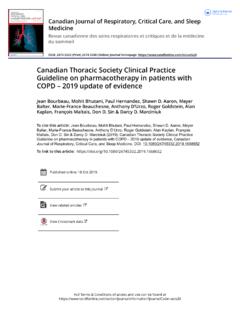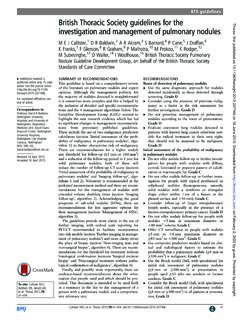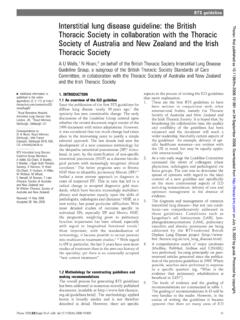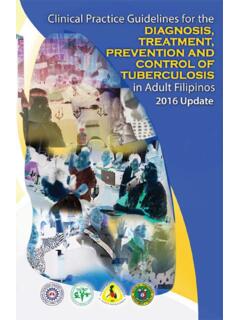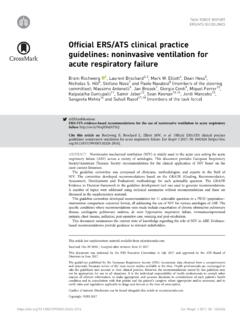Transcription of 2021 Canadian Thoracic Society Guideline – A focused ...
1 CTS guidelines AND POSITION STATEMENTS2021 Canadian Thoracic Society Guideline A focused update on themanagement of very mild and mild asthmaConnie L. Yanga, Elizabeth Anne Hicksb, Patrick Mitchellc, Joe Reismand, Delanya Podgerse,Kathleen M. Haywardf, Mark Waiteg, and Clare D. RamseyhaDepartment of Pediatrics, British Columbia Children s Hospital, University of British Columbia, Vancouver, British Columbia, Canada;bPediatric Department, University of Alberta, Edmonton, Alberta, Canada;cUniversity of Calgary, Department of Medicine, Calgary, Alberta,Canada;dPediatric Department, University of Ottawa, Children s Hospital of Eastern Ontario, Ottawa, Ontario, Canada;eKingston HealthSciences Centre, Kingston, Ontario, Canada;fCalgary COPD & Asthma Program, Alberta Health Services, Calgary, Alberta, Canada;gDepartment of Family Medicine, The Moncton Hospital, Moncton, New Brunswick, Canada.
2 HDepartment of Medicine, Rady Faculty ofHealth Sciences, University of Manitoba, Winnipeg, Manitoba, CanadaABSTRACTB ackground:This asthma Guideline update focuses on the management of individuals withasthma at the mild end of the spectrum. It applies to children 1 year of age and over and update was initiated to address new clinical trials in this patient group as well as changes inthe recommendations from the Global Initiative for Asthma (GINA) asthma strategy group. Thisguideline applies the current evidence to the Canadian :A representative multidisciplinary panel of experts undertook a formal clinical practiceguideline development process. A total of 9 key clinical questions were defined according to thePatient/problem, Intervention, Comparison, Outcome (PICO) approach. The panel performed anevidence-based, systematic literature review, assessed and graded the relevant evidence to synthe-size 11key recommendations.
3 These recommendations were reviewed in the context of the exist-ing Canadian Asthma guidelines and changes from previous guidelines are :The updated evidence demonstrated that daily inhaled corticosteroids (ICS) PRN short-act-ing beta-agonist (SABA) decrease exacerbations and improve asthma control compared to PRN SABAin individuals with very mild and mild asthma. There is new evidence in children 12 years of ageand adults that PRN budesonide/formoterol (bud/form) decreases exacerbations in comparison toPRN SABA, with different levels of evidence in those with very mild versus mild asthma. Individualswith very mild asthma at higher risk of exacerbation should be given the option of switching fromPRN SABA to daily ICS PRN SABA (all ages) or PRN bud/form ( 12 years of age). In individuals withmild asthma, daily ICS PRN SABA are still recommended as first line controller therapy.
4 However, inindividuals 12 years of age with poor adherence to daily medication despite substantial asthma edu-cation and support, PRN bud/form is an alternative. Intermittent use of very high dose ICS for acuteloss of asthma control is not suggested in preschoolers given potential for :This Guideline provides a detailed review of the evidence and provides recommenda-tions for the treatment of very mild and mild asthma within the Canadian context for pre-schoolers, children and adults. The Canadian Thoracic Society 2021 Asthma Guideline update willamalgamate these recommendations with previous guidelines to provide a document that addressdiagnosis and management of has a national prevalence of and affects Canadians over the age of 1 last Canadian Thoracic Society (CTS) asthma pos-ition statement focused on the treatment and managementof those with severe asthma,2which is estimated to affect 5-10% of those with asthma.
5 This Guideline update focuses onthose with asthma at the milder end of the spectrum, whichrepresents approximately 28-41% of the asthma populationin ,4 Although the per patient cost of asthma is 5 times higher in an individual with severe compared tomild asthma, given the high prevalence of mild asthma, thetotal cost of asthma care for these patients is majority of Canadians with asthma continue to havesuboptimal control, with surveys finding that 53-90% ofpatients had 1 or more criteria for ,7 They also continue to have severe asthma exacer-bations with the rate of Emergency Department (ED) visitsfor asthma estimated at 19-21 per 1,000 patients with 6-11%of those presenting to the ED requiring admission to specific mortality rates have decreased overtime but there continue to be deaths from asthma at a rateof per 100,000 asthma severity of an individual s asthma is classified by theintensity of treatment needed tomaintainasthma L.
6 Of Pediatrics, British Columbia Children s Hospital, Address: 4480 Oak Street, Rm 1C17,Canada, Vancouver, BC V6H 3V4 Canada. 2021 Canadian Thoracic SocietyCANADIAN JOURNAL OF RESPIRATORY, CRITICAL CARE, AND SLEEP , this is not a useful concept when deciding oninitial treatment, as asthma severity can only be determinedonce treatment has been started and asthma control is or isnot attained. In this Guideline , recommendations refer toindividuals who have well or poorly-controlled asthma onPRN short-acting beta-agonist (SABA) alone or no , given that this terminology is often used bypractitioners and unfortunate consequence ofclassifying asthma severity is that the term very mildand mild asthma suggests that there is a minimalamount of morbidity or mortality associated with it;whereas, it is known that these patients are still at riskfor asthma exacerbations and subsequent asthma themselves identified that a common barrier toimproved asthma care was the perceived lack of serious-ness of the condition.
7 6 Our previous guidelines mentioned the importance ofearly initiation of daily inhaled corticosteroids (ICS) inindividuals with symptoms less than three times a week (though the lower limit was not clearly defined), and inthose with an exacerbation requiring oral ,12 However, several practical issues with imple-mentation of this prior guidance have been observed. Forexample, patients on PRN SABA who were well-controlledas per previous CTS criteria ( , who had symptoms asoften as 3 times a week) were not typically escalated toICS therapy. In addition, if a patient had not had anexacerbation requiring oral steroids since their last visit,they were often considered to be well-controlled and mayhave been weaned off their daily controller medicationprematurely, which was not the intent of the recommen-dations in the Guideline .
8 Furthermore, patients commonlyonly take their controller medication when they feel thatit is needed, and although in some studies only 14%report not taking medication as prescribed, adherence inclinical trials (in which patients know that adherence isbeingmonitored)isonly56-75%;andmaybeco nsider-ably lower in a real-world ,13 15 This leads to apattern of intermittent ICS use that was specifically notrecommended in the CTS 2012 update. In addition tosymptom control and prevention of exacerbations, the useof daily ICS is also required to control airway inflamma-tion and may reduce ,17 OBJECTIVEThe overall objective of this CTS clinical practice guidelineis to provide an update on the management of individualswith very mild or mild asthma, currently on PRN SABA alone or on no asthma PATIENT POPULATIONThe update applies to all individuals 1yearofage with a confirmed diagnosis of asthma who arecurrently on treatment with a SABA as needed or noasthma USERSKEY DEFINITIONSP reschool refers to children 1 year of age to 5 yearsof ageChildren refers to children 6 years of age to 11 yearsof ageAdult refers to individuals 12 years of age unlessotherwise specified.
9 Individuals 12-18 years of age areincluded in this category because medication approval isoften for patients 12 years of age; however, patients 12to 18 years of age (particularly those who are prepubertal)are at higher risk for some medication side-effects such asgrowth suppression and should be monitored similarlyto childrenController A medication taken daily to decrease airwayinflammation, maintain asthma control and preventexacerbationsReliever A medication taken only as needed for quickrelief of symptoms ( , SABA, bud/form); use of>2 dosesof reliever medication in a week is a sign of poorly-controlled asthma (the number of actuations in a doseis variable depending on the reliever medication but is often1-2 actuations)SABA Short-acting beta-agonist ( , salbutamol,terbutaline)LABA Long-acting beta-agonist ( , salmeterol, formo-terol, vilanterol)FABA Fast-acting beta-agonist which can either be ashort-acting beta-agonist or a long-acting beta-agonistwith rapid onset of action.
10 In Canada, formoterol in asingle inhaler with budesonide is approved for use as afast-acting beta-agonist. The term is used in this docu-ment in reference to previous CTS guidelines , howeverfor clarity the terms SABA and bud/form will be usedwhen appropriatebud/form Single inhaler of budesonide and formoterolPRN ICS-SABA As needed use of an inhaled corticoster-oid each time a short-acting beta-agonist is taken; inCanada, this would be in 2 separate inhalers as there is notcurrently a single inhaler containing ICS and SABAS evere exacerbation: an exacerbation requiring any ofthe following:HealthcareNon-healthcareAllerg ists; Certified respiratoryeducators; Internists; Nursepractitioners/PhysicianAssistants; Pediatricians;Pharmacists; Primarycare physicians;Respirologists.
